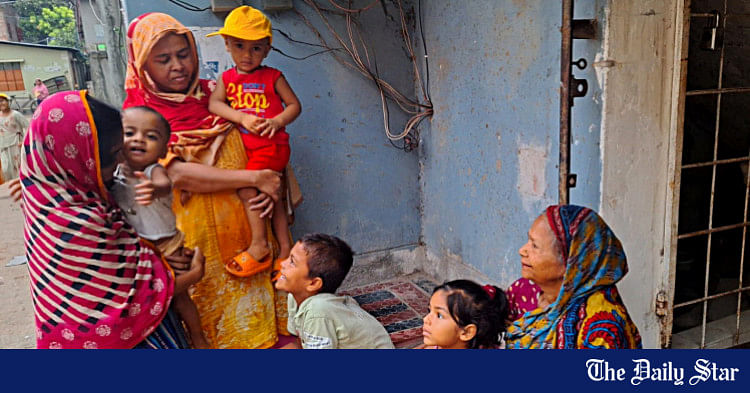Bangladesh has a population of over 170 million. With an annual population growth rate of around one percent, about two million new faces are being added to the population every year. The population size will likely stabilise at around 240-250 million, if fertility can be brought down soon to below replacement level.
Being the most densely populated country in the world, Bangladesh is at a great risk of reaching saturation in terms of agricultural production and capacity to absorb further population increases into the rural labour force.
For all latest news, follow The Daily Star’s Google News channel.
During the 1960s, fertility was high, with the total fertility rate (TFR) of over seven. It remained above six until 1981. Between 1989 and 1993-94, fertility declined sharply from 5.1 to 3.4. However, the decline was stalled at around 3.3 during 1994-2000, but then it declined sharply to 2.3 in 2011. However, it has remained at that level since then. Thus, Bangladesh has been experiencing stalling in its fertility decline since 2011.
The stall, which began in 2011, lasted for a 10-year period, ending in 2022.The increase in contraceptive prevalence rate (CPR) slowed and, indeed, almost stalled on account of the weakening of the family planning (FP) programme efforts, as the initial enthusiasm and political support waned. Since fertility stalls result in postponing the achievement of a level of fertility that is expected as well as desired, their occurrence is at the very least disconcerting.
Bangladesh received global recognition for its speedy fertility decline during 1989 to 1993-94 and 2000-2011. However, the stalling of fertility decline during 1994-2000, and especially since 2011, has become a matter of serious concern and several factors contributed to that.
One of those factors is the decline in percentage of currently married women wanting additional children. The desire to limit childbearing declined from 65 percent in 2011 to 57 percent in 2022, indicating an increase in the desire for more children.
Slower decline in child mortality in recent years is another factor. Child mortality declined substantially over the past two and a half decades; however, the decline has slowed down in recent years. Between 1993-94 and 2017-18, the under-five mortality declined from 134 to 45 and the infant mortality rate (IMR) declined from 88 to 38. However, declines were notably slow between 2017-18 and 2022, with the under-five mortality rate declining from 45 in 2017-18 to 31 and the IMR from 38 to 25.
The slowing down in the rate of increase in CPR is also a matter of concern, given the need to accelerate CPR to achieve the desired reduction in fertility. Family planning (FP) programmes achieved commendable success until 2011, with CPR rising from around four percent in the 1960s to 62 percent in 2011. However, it has remained almost unchanged (64 percent in 2022) at that level since then.
There is also a shortage of staff, including trained ones, at different levels of FP programmes, such as family welfare assistants (FWAs), family welfare visitors (FWVs), nurses, and doctors. In addition, absenteeism of providers at different levels has been commonplace. Furthermore, there is conflict between medical and non-medical personnel and between cadre and non-cadre personnel within the Directorate General of Family Planning (DGFP). Added to the HR problems are the lack of effective monitoring and supervision, and lack of transparency and accountability.
The number of home visitations are not enough as well. One-fifth of currently married women reported a visit by a fieldworker in the past six months in 2014, and it remained unchanged in 2017-18 (data for 2022 is not available). This represents a sharp decline from 43 percent in 1993-94.
Plus, there has been a decline in the relative share of long-acting or permanent method (LAPM) of contraception from 47.8 percent of modern method use in 1994 to only 14 percent in 2022. Global experience shows that the most successful FP programmes are characterised by considerably high use of LAPM. The change in the contraceptive method mix has implications for the FP programme’s overall sustainability. The decline in the relative share of LAPM should be of concern, since most childbearing is completed by the mid-to-late-20s, and women face two subsequent decades of reproductive life during which they must protect themselves from unwanted pregnancies.
A key concern for FP programmes, overly dependent on temporary modern methods, is the high rate of discontinuation, implying huge system losses for the programme. Around half of the users stop using a method within 12 months of starting its use because of method failure, side effects, health reasons, or because they want to become pregnant. Dropping out on account of side effects and method failure indicates that FP services are of low quality.
There is also a relatively high unmet need for contraception. In 2022, the unmet need for contraception was 10 percent, but if users of traditional methods (nine percent) are considered, the total unmet need for modern methods was 19 percent. Besides, exposure to FP messages in the mass media among women aged 15-49 years has also declined. For example, the percentage of women who saw a FP message on television declined from 24 percent in 2011 to 16 percent in 2017-18 (data for 2022 is not available).
FP service delivery, too, suffers from various constraints. These include, for example, inadequate funding by the government, inadequate staffing, lack of a regular, reliable and uninterrupted supply of contraceptives, inadequate behavioural change through communication messages, lack of strong technical and managerial leadership, and the limited role of NGOs and the private sector, except the Social Marketing Company (SMC). All these result in a general lack of access to good-quality FP services, especially in the low-performing areas, including urban slums.
The transition from declining fertility to its stalling should act as a signal for policymakers to do something new or strengthen existing efforts so as to restart fertility decline. This will require a strong and sustained political commitment to address the problem, and that is absent. As an example, the Population Policy of 2012 has not yet been updated even after a lapse of 12 years, reflecting a lack of commitment on the part of the health ministry. There is no doubt that the Bangladesh Family Planning Programme has lost much of the focus and priority it received until the mid-1990s. To fully achieve its development objectives and bring about the desired reduction in fertility levels, the government should attach high priority to the FP programme (especially giving top priority to high-parity couples, and give greater focus on acceptance of LAPM).
Hence, there is clearly a need to develop a supportive and proactive policy environment by sensitising the political leadership and other stakeholders about the dangers of the fertility stalling in the country. Also, there is a need for a more inclusive strategy, involving greater involvement and participation of all concerned ministries, especially the local government ministry that is entrusted with the responsibility of providing FP services in urban areas, NGOs, the private sector and professional groups. The political leadership should renew its commitment to contain the rate of population growth, as it had until the mid-1990s, instead of putting the issue on the backburner. Therefore, responding to the signal will require, among other things, rejuvenating and strengthening the FP programme, bringing about substantial rise in female ages at marriage and childbearing, increasing female schooling and employment, and improving child survival rates.
Barkat-e-Khuda, PhD, is a former professor and chairman of the Department of Economics at Dhaka University. He can be reached at [email protected].
Views expressed in this article are the author’s own.
Follow The Daily Star Opinion on Facebook for the latest opinions, commentaries and analyses by experts and professionals. To contribute your article or letter to The Daily Star Opinion, see our guidelines for submission.




